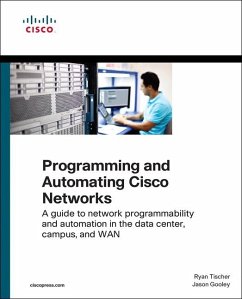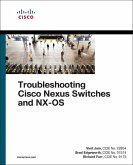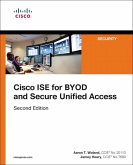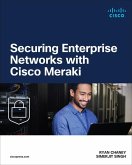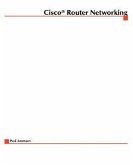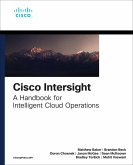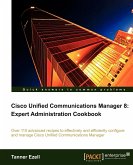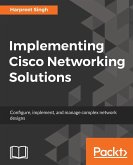Ryan Tischer, Jason Gooley
Programming and Automating Cisco Networks
A Guide to Network Programmability and Automation in the Data Center, Campus, and WAN
Ryan Tischer, Jason Gooley
Programming and Automating Cisco Networks
A Guide to Network Programmability and Automation in the Data Center, Campus, and WAN
- Broschiertes Buch
- Merkliste
- Auf die Merkliste
- Bewerten Bewerten
- Teilen
- Produkt teilen
- Produkterinnerung
- Produkterinnerung
Traditional approaches to network management can't handle soaring network complexity. In the future, the best way to stay in control of your networks will be to program and automate them. Programming and Automating Cisco Networks introduces powerful new Cisco technologies for doing just that. CCIEs Ryan Tischer and Jason Gooley begin by showing how network automation and programmability can bridge gaps in network management arising from modern operational models. Next, they introduce software development tools, use cases, and examples for programming the Nexus 9000 and other Cisco data center…mehr
Andere Kunden interessierten sich auch für
![Troubleshooting Cisco Nexus Switches and Nx-OS Troubleshooting Cisco Nexus Switches and Nx-OS]() Vinit JainTroubleshooting Cisco Nexus Switches and Nx-OS74,99 €
Vinit JainTroubleshooting Cisco Nexus Switches and Nx-OS74,99 €![Cisco Ise for Byod and Secure Unified Access Cisco Ise for Byod and Secure Unified Access]() Aaron WolandCisco Ise for Byod and Secure Unified Access75,99 €
Aaron WolandCisco Ise for Byod and Secure Unified Access75,99 €![Securing Enterprise Networks with Cisco Meraki Securing Enterprise Networks with Cisco Meraki]() Ryan ChaneySecuring Enterprise Networks with Cisco Meraki75,99 €
Ryan ChaneySecuring Enterprise Networks with Cisco Meraki75,99 €![Cisco Router Internetworking Cisco Router Internetworking]() Cisco Router Internetworking64,99 €
Cisco Router Internetworking64,99 €![Cisco Intersight Cisco Intersight]() Matthew BakerCisco Intersight54,99 €
Matthew BakerCisco Intersight54,99 €![Cisco Unified Communications Manager 8 Cisco Unified Communications Manager 8]() Tanner EzellCisco Unified Communications Manager 877,99 €
Tanner EzellCisco Unified Communications Manager 877,99 €![Implementing Cisco Networking Solutions Implementing Cisco Networking Solutions]() Harpreet SinghImplementing Cisco Networking Solutions55,99 €
Harpreet SinghImplementing Cisco Networking Solutions55,99 €-
-
-
Traditional approaches to network management can't handle soaring network complexity. In the future, the best way to stay in control of your networks will be to program and automate them. Programming and Automating Cisco Networks introduces powerful new Cisco technologies for doing just that. CCIEs Ryan Tischer and Jason Gooley begin by showing how network automation and programmability can bridge gaps in network management arising from modern operational models. Next, they introduce software development tools, use cases, and examples for programming the Nexus 9000 and other Cisco data center network platforms. You'll find detailed coverage of programmability for Cisco campus and WAN products, including the use of NetConf/Yang, ConfD, and Cisco SDN controller for managing complex WAN environments. Tischer and Gooley then introduce Cisco's self-service catalog, Prime Services, and techniques for orchestrating multiple automation solutions to deliver applications, using Cisco Process Orchestrator. They conclude with links and references for extending your network automation skills via online communities and open source projects.
Hinweis: Dieser Artikel kann nur an eine deutsche Lieferadresse ausgeliefert werden.
Hinweis: Dieser Artikel kann nur an eine deutsche Lieferadresse ausgeliefert werden.
Produktdetails
- Produktdetails
- Verlag: Pearson Education
- Seitenzahl: 368
- Erscheinungstermin: 9. September 2016
- Englisch
- Abmessung: 231mm x 187mm x 25mm
- Gewicht: 619g
- ISBN-13: 9781587144653
- ISBN-10: 1587144654
- Artikelnr.: 44161542
- Herstellerkennzeichnung
- Libri GmbH
- Europaallee 1
- 36244 Bad Hersfeld
- gpsr@libri.de
- Verlag: Pearson Education
- Seitenzahl: 368
- Erscheinungstermin: 9. September 2016
- Englisch
- Abmessung: 231mm x 187mm x 25mm
- Gewicht: 619g
- ISBN-13: 9781587144653
- ISBN-10: 1587144654
- Artikelnr.: 44161542
- Herstellerkennzeichnung
- Libri GmbH
- Europaallee 1
- 36244 Bad Hersfeld
- gpsr@libri.de
Ryan Tischer, CCIE No. 11459 is a Technical Solution Architect at Cisco where he focuses on SDN, Cloud, and network programmability. He has worked in IT for 20 years, specifically focused on design, deployment, and operations of networking technologies. Ryan holds a BA in Information Technology from the University of Massachusetts, Lowell and a MS in Network Engineering from Depaul University. Ryan lives with his wife and children in the Milwaukee, WI area. Ryan blogs at http://Policyetc.com. Jason Gooley, CCIE No. 38759 (R&S & SP), is a very enthusiastic engineer that is passionate about helping others in the industry succeed. Jason has more than 20 years of experience in the Information Technology and Telecommunications industry. Jason currently works at Cisco as a Strategic Systems Engineer where he specializes in SD-WAN, campus, and data center network design. In addition, Jason works with Learning@Cisco on certification development, mentoring, and training. Jason is also a Program Committee member and organizer for the Chicago Network Operators Group (CHINOG). Jason lives in Illinois with his wife Jamie and their daughter Kaleigh.
Introduction xviii
Section I Getting Started with Network Programmability
Chapter 1 Introduction: Why Network Programmability 1
What Is Network Programmability 3
Network Programmability Benefits 4
Cloud, SDN, and Network Programmability 6
SDN 8
Is Programmability a New Idea? 9
Network Automation 10
Summary 11
Chapter 2 Foundational Skills 13
Introduction to Software Development 13
Common Constructs–Variables, Flow Control, Functions, and Objects 15
A Basic Introduction to Python 20
APIs and SDKs 37
Web Technologies 37
Web Technologies–Data Formatting 38
Google Postman 40
Basic Introduction to Version Control, Git, and GitHub 45
Git–Add a File 47
Creating and Editing Source Code 49
Getting Started with PyCharm 50
Introduction to Linux 55
Working in Linux 56
Using Systemd 61
Summary 66
Section II Cisco Programmable Data Center
Chapter 3 Next-Generation Cisco Data Center Networking 67
Cisco Application-Centric Infrastructure (ACI) 70
Nexus Data Broker 74
Use Case–Nexus Data Broker 75
Evolution of Data Center Network Architecture 76
Cisco Data Center Network Controllers 80
Nexus Fabric Manager 80
Virtual Topology System (VTS) 81
Cisco ACI 81
Summary 82
Chapter 4 On-Box Programmability and Automation with Cisco Nexus NX-OS 83
Open NX-OS Automation–Bootstrap and Provisioning 83
Cisco POAP 83
Cisco Ignite 87
NX-OS iPXE 88
Bash 88
Bash Scripting 89
Bash Variables, Conditions, and Loops 89
Bash Arithmetic 90
Bash Conditions and Flow Control 91
Bash Redirection and Pipes 94
Working with Text in Bash 96
Awk 98
Bash on Nexus 9000 99
ifconfig 101
Tcpdump 101
ethtool 103
Run a Bash Script at Startup 103
Linux Containers (LXC) 106
Network Access in Guestshell 109
EEM Variables 113
On-box Python Scripting 113
On-Box Python–Use Cases and Examples 118
EEM Neighbor Discovery 121
Summary 124
Chapter 5 Off-Box Programmability and Automation with Cisco Nexus NX-OS 125
Nexus NX-API 125
NX-API Transport 125
NX-API Message Format 126
NX-API Security 126
NX-API Sandbox 127
Summary 158
Resources 158
Chapter 6 Network Programmability with Cisco ACI 159
Cisco ACI Automation 160
ACI Policy Instantiation 161
A Bit More Python 162
Python Exceptions Handling 166
ACI Fundamentals 169
ACI Management Information Model 169
ACI Programmability 174
Cobra SDK 198
Summary 213
Section III Cisco Programmable Campus and WAN
Chapter 7 On-Box Automation and Operations Tools 215
Automated Port Profiling 216
AutoSmart Ports 216
Enabling AutoSmart Ports on a Cisco Catalyst Switch 217
AutoConf 220
Enabling AutoConf on a Cisco Catalyst Switch 222
Modifying a Built-in Template 224
Auto Security 227
Enabling Auto Security on a Cisco Catalyst Switch 228
Quality of Service for Campus Architectures 230
AutoQoS on Campus LAN Devices 230
Enabling AutoQoS on a Cisco Catalyst Switch 231
AutoQoS on Campus WAN Devices 233
Enabling AutoQoS on a Cisco ISR Router 234
Automating Management and Monitoring Tasks 236
Smart Call Home 236
Enabling Smart Call Home on an Cisco Catalyst Switch 237
Tcl Shell 243
Embedded Event Manager (EEM) 246
Summary 253
Chapter 8 Network Automation Tools for Campus Environments 255
Data Models and Supporting Protocols 256
YANG Data Models 256
NETCONF 258
ConfD 259
Application Policy Infrastructure Controller Enterprise Module (APIC-EM)
263
APIC-EM Architecture 263
APIC-EM Applications 264
Intelligent WAN (IWAN) Application 264
Plug and Play (PnP) Application 269
Path Trace Application 276
Additional APIC-EM Features 279
Topology 279
Device Inventory 281
Easy Quality of Service (Easy QoS) 283
Dynamic QoS 285
Policy Application 286
APIC-EM Programmability Examples Using Postman 288
Ticket API 288
Host API 291
Network Device API 292
User API 294
Available APIC-EM APIs 296
APIC-EM Programmability Examples Using Python 297
Ticket API 297
Host API 299
Summary 302
Chapter 9 Piecing It All Together 303
9781587144653, TOC, 8/1/2016
Section I Getting Started with Network Programmability
Chapter 1 Introduction: Why Network Programmability 1
What Is Network Programmability 3
Network Programmability Benefits 4
Cloud, SDN, and Network Programmability 6
SDN 8
Is Programmability a New Idea? 9
Network Automation 10
Summary 11
Chapter 2 Foundational Skills 13
Introduction to Software Development 13
Common Constructs–Variables, Flow Control, Functions, and Objects 15
A Basic Introduction to Python 20
APIs and SDKs 37
Web Technologies 37
Web Technologies–Data Formatting 38
Google Postman 40
Basic Introduction to Version Control, Git, and GitHub 45
Git–Add a File 47
Creating and Editing Source Code 49
Getting Started with PyCharm 50
Introduction to Linux 55
Working in Linux 56
Using Systemd 61
Summary 66
Section II Cisco Programmable Data Center
Chapter 3 Next-Generation Cisco Data Center Networking 67
Cisco Application-Centric Infrastructure (ACI) 70
Nexus Data Broker 74
Use Case–Nexus Data Broker 75
Evolution of Data Center Network Architecture 76
Cisco Data Center Network Controllers 80
Nexus Fabric Manager 80
Virtual Topology System (VTS) 81
Cisco ACI 81
Summary 82
Chapter 4 On-Box Programmability and Automation with Cisco Nexus NX-OS 83
Open NX-OS Automation–Bootstrap and Provisioning 83
Cisco POAP 83
Cisco Ignite 87
NX-OS iPXE 88
Bash 88
Bash Scripting 89
Bash Variables, Conditions, and Loops 89
Bash Arithmetic 90
Bash Conditions and Flow Control 91
Bash Redirection and Pipes 94
Working with Text in Bash 96
Awk 98
Bash on Nexus 9000 99
ifconfig 101
Tcpdump 101
ethtool 103
Run a Bash Script at Startup 103
Linux Containers (LXC) 106
Network Access in Guestshell 109
EEM Variables 113
On-box Python Scripting 113
On-Box Python–Use Cases and Examples 118
EEM Neighbor Discovery 121
Summary 124
Chapter 5 Off-Box Programmability and Automation with Cisco Nexus NX-OS 125
Nexus NX-API 125
NX-API Transport 125
NX-API Message Format 126
NX-API Security 126
NX-API Sandbox 127
Summary 158
Resources 158
Chapter 6 Network Programmability with Cisco ACI 159
Cisco ACI Automation 160
ACI Policy Instantiation 161
A Bit More Python 162
Python Exceptions Handling 166
ACI Fundamentals 169
ACI Management Information Model 169
ACI Programmability 174
Cobra SDK 198
Summary 213
Section III Cisco Programmable Campus and WAN
Chapter 7 On-Box Automation and Operations Tools 215
Automated Port Profiling 216
AutoSmart Ports 216
Enabling AutoSmart Ports on a Cisco Catalyst Switch 217
AutoConf 220
Enabling AutoConf on a Cisco Catalyst Switch 222
Modifying a Built-in Template 224
Auto Security 227
Enabling Auto Security on a Cisco Catalyst Switch 228
Quality of Service for Campus Architectures 230
AutoQoS on Campus LAN Devices 230
Enabling AutoQoS on a Cisco Catalyst Switch 231
AutoQoS on Campus WAN Devices 233
Enabling AutoQoS on a Cisco ISR Router 234
Automating Management and Monitoring Tasks 236
Smart Call Home 236
Enabling Smart Call Home on an Cisco Catalyst Switch 237
Tcl Shell 243
Embedded Event Manager (EEM) 246
Summary 253
Chapter 8 Network Automation Tools for Campus Environments 255
Data Models and Supporting Protocols 256
YANG Data Models 256
NETCONF 258
ConfD 259
Application Policy Infrastructure Controller Enterprise Module (APIC-EM)
263
APIC-EM Architecture 263
APIC-EM Applications 264
Intelligent WAN (IWAN) Application 264
Plug and Play (PnP) Application 269
Path Trace Application 276
Additional APIC-EM Features 279
Topology 279
Device Inventory 281
Easy Quality of Service (Easy QoS) 283
Dynamic QoS 285
Policy Application 286
APIC-EM Programmability Examples Using Postman 288
Ticket API 288
Host API 291
Network Device API 292
User API 294
Available APIC-EM APIs 296
APIC-EM Programmability Examples Using Python 297
Ticket API 297
Host API 299
Summary 302
Chapter 9 Piecing It All Together 303
9781587144653, TOC, 8/1/2016
Introduction xviii
Section I Getting Started with Network Programmability
Chapter 1 Introduction: Why Network Programmability 1
What Is Network Programmability 3
Network Programmability Benefits 4
Cloud, SDN, and Network Programmability 6
SDN 8
Is Programmability a New Idea? 9
Network Automation 10
Summary 11
Chapter 2 Foundational Skills 13
Introduction to Software Development 13
Common Constructs–Variables, Flow Control, Functions, and Objects 15
A Basic Introduction to Python 20
APIs and SDKs 37
Web Technologies 37
Web Technologies–Data Formatting 38
Google Postman 40
Basic Introduction to Version Control, Git, and GitHub 45
Git–Add a File 47
Creating and Editing Source Code 49
Getting Started with PyCharm 50
Introduction to Linux 55
Working in Linux 56
Using Systemd 61
Summary 66
Section II Cisco Programmable Data Center
Chapter 3 Next-Generation Cisco Data Center Networking 67
Cisco Application-Centric Infrastructure (ACI) 70
Nexus Data Broker 74
Use Case–Nexus Data Broker 75
Evolution of Data Center Network Architecture 76
Cisco Data Center Network Controllers 80
Nexus Fabric Manager 80
Virtual Topology System (VTS) 81
Cisco ACI 81
Summary 82
Chapter 4 On-Box Programmability and Automation with Cisco Nexus NX-OS 83
Open NX-OS Automation–Bootstrap and Provisioning 83
Cisco POAP 83
Cisco Ignite 87
NX-OS iPXE 88
Bash 88
Bash Scripting 89
Bash Variables, Conditions, and Loops 89
Bash Arithmetic 90
Bash Conditions and Flow Control 91
Bash Redirection and Pipes 94
Working with Text in Bash 96
Awk 98
Bash on Nexus 9000 99
ifconfig 101
Tcpdump 101
ethtool 103
Run a Bash Script at Startup 103
Linux Containers (LXC) 106
Network Access in Guestshell 109
EEM Variables 113
On-box Python Scripting 113
On-Box Python–Use Cases and Examples 118
EEM Neighbor Discovery 121
Summary 124
Chapter 5 Off-Box Programmability and Automation with Cisco Nexus NX-OS 125
Nexus NX-API 125
NX-API Transport 125
NX-API Message Format 126
NX-API Security 126
NX-API Sandbox 127
Summary 158
Resources 158
Chapter 6 Network Programmability with Cisco ACI 159
Cisco ACI Automation 160
ACI Policy Instantiation 161
A Bit More Python 162
Python Exceptions Handling 166
ACI Fundamentals 169
ACI Management Information Model 169
ACI Programmability 174
Cobra SDK 198
Summary 213
Section III Cisco Programmable Campus and WAN
Chapter 7 On-Box Automation and Operations Tools 215
Automated Port Profiling 216
AutoSmart Ports 216
Enabling AutoSmart Ports on a Cisco Catalyst Switch 217
AutoConf 220
Enabling AutoConf on a Cisco Catalyst Switch 222
Modifying a Built-in Template 224
Auto Security 227
Enabling Auto Security on a Cisco Catalyst Switch 228
Quality of Service for Campus Architectures 230
AutoQoS on Campus LAN Devices 230
Enabling AutoQoS on a Cisco Catalyst Switch 231
AutoQoS on Campus WAN Devices 233
Enabling AutoQoS on a Cisco ISR Router 234
Automating Management and Monitoring Tasks 236
Smart Call Home 236
Enabling Smart Call Home on an Cisco Catalyst Switch 237
Tcl Shell 243
Embedded Event Manager (EEM) 246
Summary 253
Chapter 8 Network Automation Tools for Campus Environments 255
Data Models and Supporting Protocols 256
YANG Data Models 256
NETCONF 258
ConfD 259
Application Policy Infrastructure Controller Enterprise Module (APIC-EM)
263
APIC-EM Architecture 263
APIC-EM Applications 264
Intelligent WAN (IWAN) Application 264
Plug and Play (PnP) Application 269
Path Trace Application 276
Additional APIC-EM Features 279
Topology 279
Device Inventory 281
Easy Quality of Service (Easy QoS) 283
Dynamic QoS 285
Policy Application 286
APIC-EM Programmability Examples Using Postman 288
Ticket API 288
Host API 291
Network Device API 292
User API 294
Available APIC-EM APIs 296
APIC-EM Programmability Examples Using Python 297
Ticket API 297
Host API 299
Summary 302
Chapter 9 Piecing It All Together 303
9781587144653, TOC, 8/1/2016
Section I Getting Started with Network Programmability
Chapter 1 Introduction: Why Network Programmability 1
What Is Network Programmability 3
Network Programmability Benefits 4
Cloud, SDN, and Network Programmability 6
SDN 8
Is Programmability a New Idea? 9
Network Automation 10
Summary 11
Chapter 2 Foundational Skills 13
Introduction to Software Development 13
Common Constructs–Variables, Flow Control, Functions, and Objects 15
A Basic Introduction to Python 20
APIs and SDKs 37
Web Technologies 37
Web Technologies–Data Formatting 38
Google Postman 40
Basic Introduction to Version Control, Git, and GitHub 45
Git–Add a File 47
Creating and Editing Source Code 49
Getting Started with PyCharm 50
Introduction to Linux 55
Working in Linux 56
Using Systemd 61
Summary 66
Section II Cisco Programmable Data Center
Chapter 3 Next-Generation Cisco Data Center Networking 67
Cisco Application-Centric Infrastructure (ACI) 70
Nexus Data Broker 74
Use Case–Nexus Data Broker 75
Evolution of Data Center Network Architecture 76
Cisco Data Center Network Controllers 80
Nexus Fabric Manager 80
Virtual Topology System (VTS) 81
Cisco ACI 81
Summary 82
Chapter 4 On-Box Programmability and Automation with Cisco Nexus NX-OS 83
Open NX-OS Automation–Bootstrap and Provisioning 83
Cisco POAP 83
Cisco Ignite 87
NX-OS iPXE 88
Bash 88
Bash Scripting 89
Bash Variables, Conditions, and Loops 89
Bash Arithmetic 90
Bash Conditions and Flow Control 91
Bash Redirection and Pipes 94
Working with Text in Bash 96
Awk 98
Bash on Nexus 9000 99
ifconfig 101
Tcpdump 101
ethtool 103
Run a Bash Script at Startup 103
Linux Containers (LXC) 106
Network Access in Guestshell 109
EEM Variables 113
On-box Python Scripting 113
On-Box Python–Use Cases and Examples 118
EEM Neighbor Discovery 121
Summary 124
Chapter 5 Off-Box Programmability and Automation with Cisco Nexus NX-OS 125
Nexus NX-API 125
NX-API Transport 125
NX-API Message Format 126
NX-API Security 126
NX-API Sandbox 127
Summary 158
Resources 158
Chapter 6 Network Programmability with Cisco ACI 159
Cisco ACI Automation 160
ACI Policy Instantiation 161
A Bit More Python 162
Python Exceptions Handling 166
ACI Fundamentals 169
ACI Management Information Model 169
ACI Programmability 174
Cobra SDK 198
Summary 213
Section III Cisco Programmable Campus and WAN
Chapter 7 On-Box Automation and Operations Tools 215
Automated Port Profiling 216
AutoSmart Ports 216
Enabling AutoSmart Ports on a Cisco Catalyst Switch 217
AutoConf 220
Enabling AutoConf on a Cisco Catalyst Switch 222
Modifying a Built-in Template 224
Auto Security 227
Enabling Auto Security on a Cisco Catalyst Switch 228
Quality of Service for Campus Architectures 230
AutoQoS on Campus LAN Devices 230
Enabling AutoQoS on a Cisco Catalyst Switch 231
AutoQoS on Campus WAN Devices 233
Enabling AutoQoS on a Cisco ISR Router 234
Automating Management and Monitoring Tasks 236
Smart Call Home 236
Enabling Smart Call Home on an Cisco Catalyst Switch 237
Tcl Shell 243
Embedded Event Manager (EEM) 246
Summary 253
Chapter 8 Network Automation Tools for Campus Environments 255
Data Models and Supporting Protocols 256
YANG Data Models 256
NETCONF 258
ConfD 259
Application Policy Infrastructure Controller Enterprise Module (APIC-EM)
263
APIC-EM Architecture 263
APIC-EM Applications 264
Intelligent WAN (IWAN) Application 264
Plug and Play (PnP) Application 269
Path Trace Application 276
Additional APIC-EM Features 279
Topology 279
Device Inventory 281
Easy Quality of Service (Easy QoS) 283
Dynamic QoS 285
Policy Application 286
APIC-EM Programmability Examples Using Postman 288
Ticket API 288
Host API 291
Network Device API 292
User API 294
Available APIC-EM APIs 296
APIC-EM Programmability Examples Using Python 297
Ticket API 297
Host API 299
Summary 302
Chapter 9 Piecing It All Together 303
9781587144653, TOC, 8/1/2016

